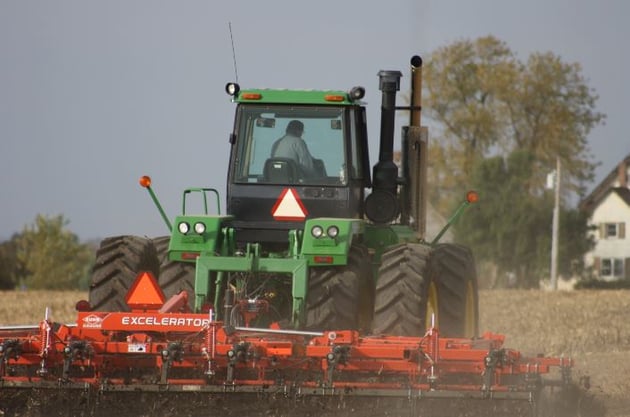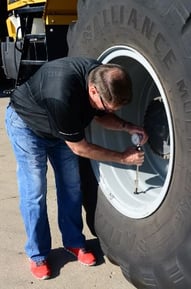Quick and Easy Tips for Checking Your Farm Tres
It’s getting to be a busy time on farms all around the country and in Canada, with lots of activity happening in the lead-up to Spring planting. For many farmers, this is also the first time that tractors and other machinery and implements have left the barn since November. If you didn’t have time, or forgot to do so over the winter months, it’s a great idea to get in the habit of giving your tires a good thorough “going-over” before heading into the field for the first time. This simple annual practice could save you time, aggravation, and money.

Visual Inspection
One of the simplest things you can do to get the best out of your machinery is to visually inspect tires before sending them into the field. Take a close look at each tire’s sidewall and make sure there are no nicks or dings. After that, inspect the tread and look for stubble damage. If the tread looks worn, it may be more cost effective to buy new tires, as the amount of slippage new tires could reduce may pay for the tire in fuel and time savings.
Is it Time for a New Tire or Will They Last One More Season?
Although there is no “penny test” to tell you when it’s time for new ag tires, you can always use common sense. For example, if you see anything other than rubber when visually inspecting your tires, it’s time for new ones. Also, if you find yourself questioning whether a tire is good or not, the time for new tires is now. As we're fond of saying, “if a tire is looking bad now, it’s never going to get any better.”
According to Murphy’s Law, the tire that you were questioning this spring will fail at the absolute worst time. Not only will this tire failure disrupt vital operations on the farm, but it will be more expensive to fix in the moment. Emergencies are costly, and no one has ever gotten a deal on a tire when they needed one. By planning ahead, you not only get the tires you need, but the tires you want, and perhaps at a better price.
The Pressure is On (and Off…)
 While it might seem like not much is happening in the barn over the winter, your tires will be experiencing dynamic temperature conditions. In a standard row crop tire, every 10-degree change in ambient temperature causes about 1 psi of pressure change. Now think about that unseasonably warm 70-degree day in November when you put the tractor up, and think that one cold day in March when you pulled it out. The psi you lost will not only have an effect on the performance of your tires, but also on their lifespan.
While it might seem like not much is happening in the barn over the winter, your tires will be experiencing dynamic temperature conditions. In a standard row crop tire, every 10-degree change in ambient temperature causes about 1 psi of pressure change. Now think about that unseasonably warm 70-degree day in November when you put the tractor up, and think that one cold day in March when you pulled it out. The psi you lost will not only have an effect on the performance of your tires, but also on their lifespan.
The message? Check the air pressure to ensure proper inflation of your tires. To figure out the optimum operating pressure, you’ll need the tire’s pressure tables (available at most manufacturers’ websites or through your tire dealer). You’ll also need to know at least the weight of the machine fully fueled and loaded, and the weight of your implement. A simple way to get the “real-world” weight of your equipment is at the grain elevator. Every elevator has a scale, and next time you're there, make a note of the weight of your machine and implement.
Double Trouble
For operators running dual tires, checking the inside tire will be super important even though it’s a hassle. Having an underinflated inside tire means you're not getting the flotation and traction advantages of running two tires, and could even be overtaxing the outside tire causing it to wear more quickly and risking premature failure.
With so many cost and profit factors that are outside of a farmer’s control, it’s important to manage the things that they can, and tire expenses are one of them. Although we’ll never be able to predict the weather, commodity prices, or the price of fuel, having a great set of tires in good condition can prepare you for many of the unknowns. They can reduce slippage, help save fuel, and help you avoid costly downtime—all things that will help you be more profitable.


